Reconciling Economic & Environmental Challenges: Climate Change
VerifiedAdded on 2022/12/28
|8
|1664
|57
Essay
AI Summary
This essay delves into the reconciliation of economic and environmental challenges, particularly climate change, in the 21st century. It examines various economic instruments proposed to address these challenges, including the Emissions Reduction Fund, carbon taxes, and the Cap and Trade system, evaluating their advantages and disadvantages. The essay discusses the Australian government's Emissions Reduction Fund, highlighting its support for businesses and land managers in reducing emissions, while also noting criticisms regarding its scalability and cost-effectiveness. It further analyzes carbon taxes, introduced in Australia through the Clean Energy Act, and the Cap and Trade system, assessing their impacts on emissions reduction, economic costs, and incentives for cleaner technologies. The essay concludes by advocating for policies that provide strong economic signals for transitioning to cleaner energy, acknowledging the complexities and trade-offs associated with each approach.
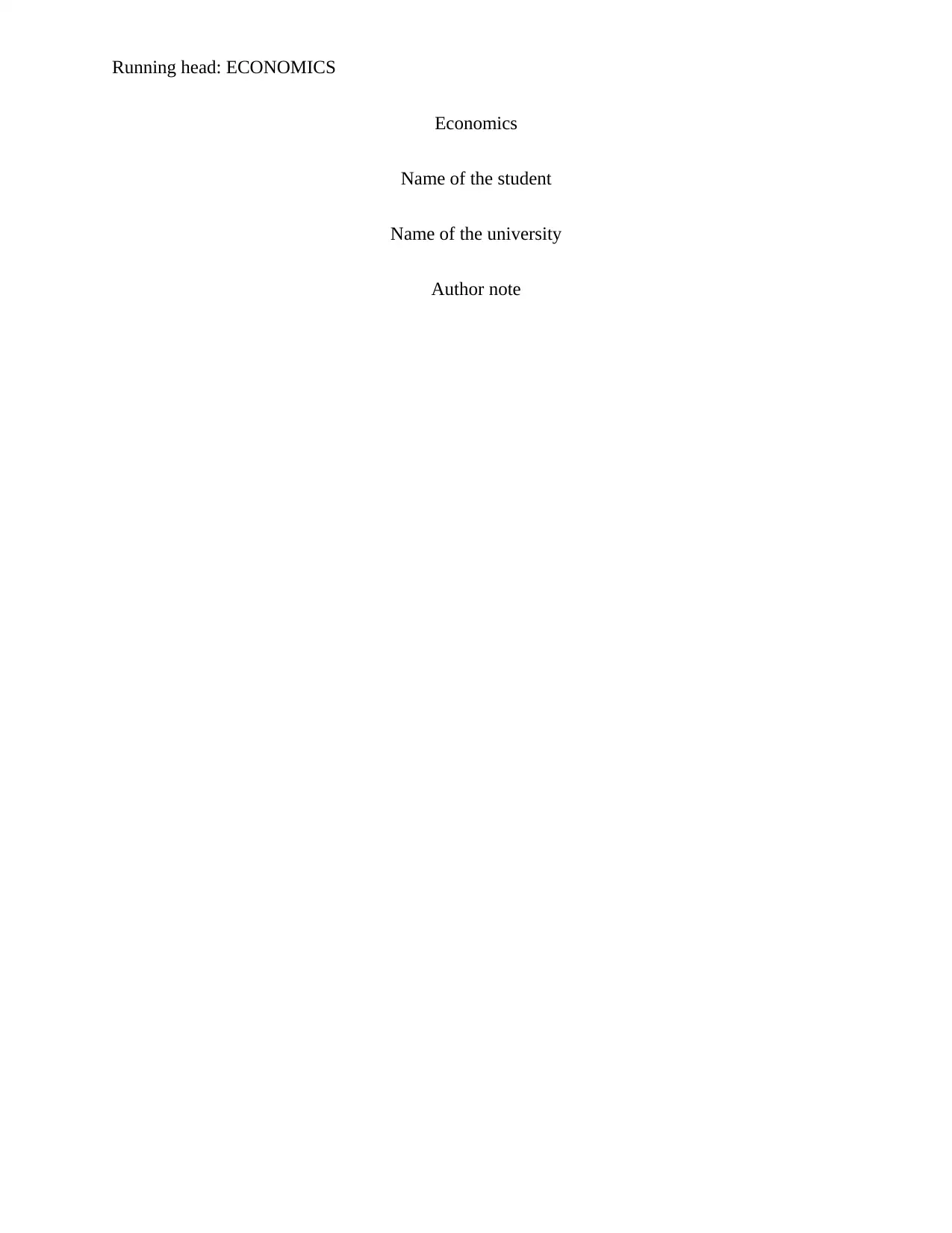
Running head: ECONOMICS
Economics
Name of the student
Name of the university
Author note
Economics
Name of the student
Name of the university
Author note
Paraphrase This Document
Need a fresh take? Get an instant paraphrase of this document with our AI Paraphraser
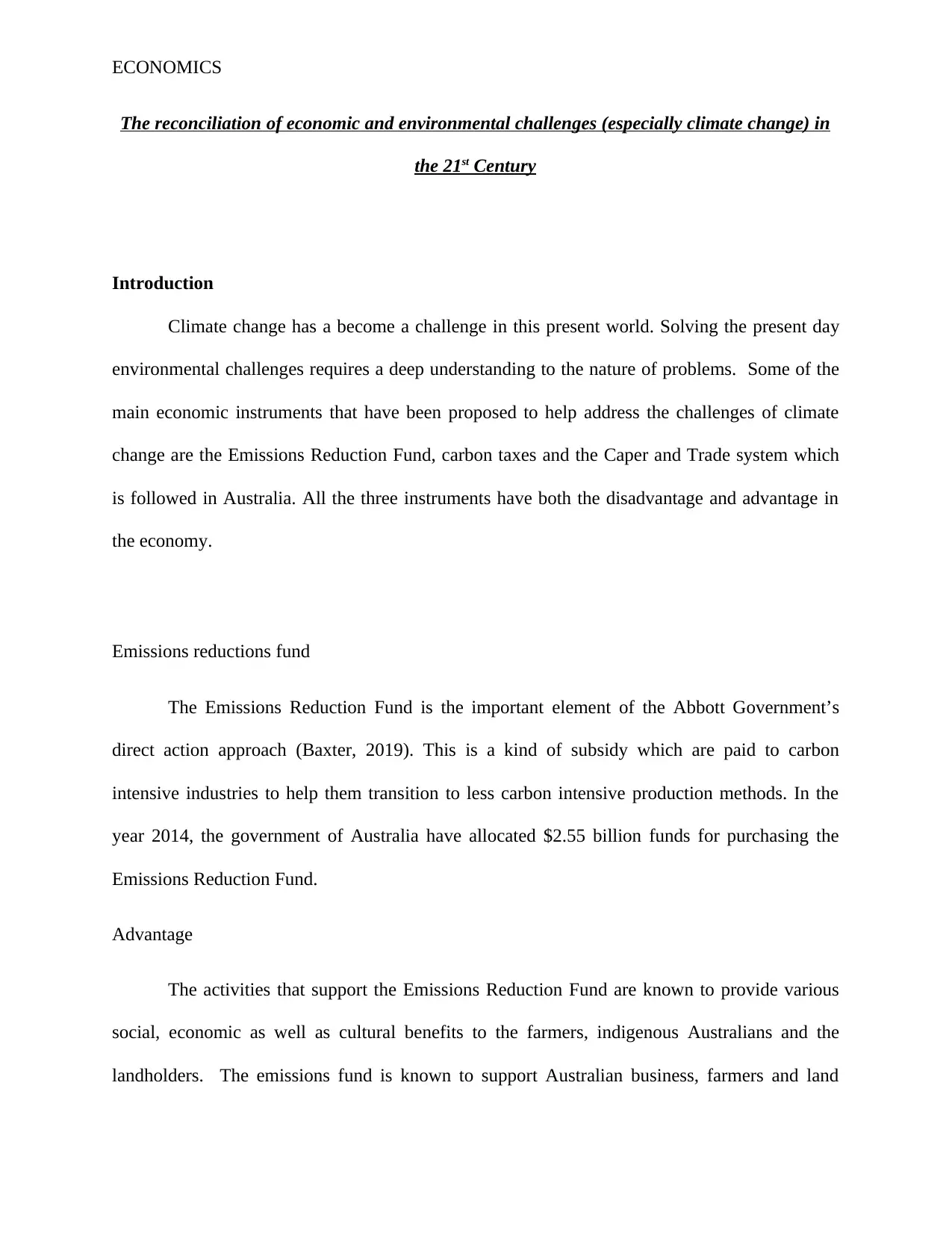
ECONOMICS
The reconciliation of economic and environmental challenges (especially climate change) in
the 21st Century
Introduction
Climate change has a become a challenge in this present world. Solving the present day
environmental challenges requires a deep understanding to the nature of problems. Some of the
main economic instruments that have been proposed to help address the challenges of climate
change are the Emissions Reduction Fund, carbon taxes and the Caper and Trade system which
is followed in Australia. All the three instruments have both the disadvantage and advantage in
the economy.
Emissions reductions fund
The Emissions Reduction Fund is the important element of the Abbott Government’s
direct action approach (Baxter, 2019). This is a kind of subsidy which are paid to carbon
intensive industries to help them transition to less carbon intensive production methods. In the
year 2014, the government of Australia have allocated $2.55 billion funds for purchasing the
Emissions Reduction Fund.
Advantage
The activities that support the Emissions Reduction Fund are known to provide various
social, economic as well as cultural benefits to the farmers, indigenous Australians and the
landholders. The emissions fund is known to support Australian business, farmers and land
The reconciliation of economic and environmental challenges (especially climate change) in
the 21st Century
Introduction
Climate change has a become a challenge in this present world. Solving the present day
environmental challenges requires a deep understanding to the nature of problems. Some of the
main economic instruments that have been proposed to help address the challenges of climate
change are the Emissions Reduction Fund, carbon taxes and the Caper and Trade system which
is followed in Australia. All the three instruments have both the disadvantage and advantage in
the economy.
Emissions reductions fund
The Emissions Reduction Fund is the important element of the Abbott Government’s
direct action approach (Baxter, 2019). This is a kind of subsidy which are paid to carbon
intensive industries to help them transition to less carbon intensive production methods. In the
year 2014, the government of Australia have allocated $2.55 billion funds for purchasing the
Emissions Reduction Fund.
Advantage
The activities that support the Emissions Reduction Fund are known to provide various
social, economic as well as cultural benefits to the farmers, indigenous Australians and the
landholders. The emissions fund is known to support Australian business, farmers and land
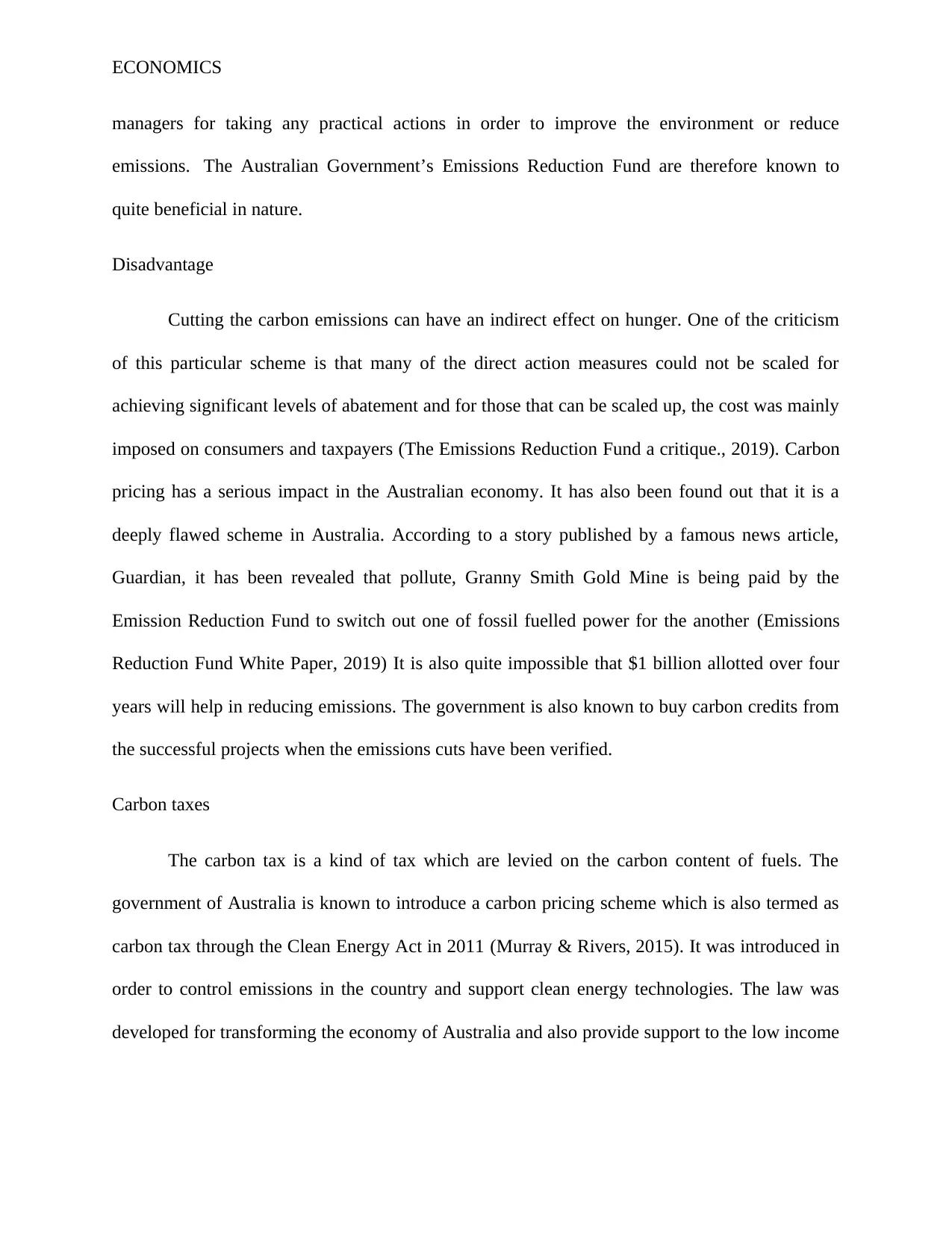
ECONOMICS
managers for taking any practical actions in order to improve the environment or reduce
emissions. The Australian Government’s Emissions Reduction Fund are therefore known to
quite beneficial in nature.
Disadvantage
Cutting the carbon emissions can have an indirect effect on hunger. One of the criticism
of this particular scheme is that many of the direct action measures could not be scaled for
achieving significant levels of abatement and for those that can be scaled up, the cost was mainly
imposed on consumers and taxpayers (The Emissions Reduction Fund a critique., 2019). Carbon
pricing has a serious impact in the Australian economy. It has also been found out that it is a
deeply flawed scheme in Australia. According to a story published by a famous news article,
Guardian, it has been revealed that pollute, Granny Smith Gold Mine is being paid by the
Emission Reduction Fund to switch out one of fossil fuelled power for the another (Emissions
Reduction Fund White Paper, 2019) It is also quite impossible that $1 billion allotted over four
years will help in reducing emissions. The government is also known to buy carbon credits from
the successful projects when the emissions cuts have been verified.
Carbon taxes
The carbon tax is a kind of tax which are levied on the carbon content of fuels. The
government of Australia is known to introduce a carbon pricing scheme which is also termed as
carbon tax through the Clean Energy Act in 2011 (Murray & Rivers, 2015). It was introduced in
order to control emissions in the country and support clean energy technologies. The law was
developed for transforming the economy of Australia and also provide support to the low income
managers for taking any practical actions in order to improve the environment or reduce
emissions. The Australian Government’s Emissions Reduction Fund are therefore known to
quite beneficial in nature.
Disadvantage
Cutting the carbon emissions can have an indirect effect on hunger. One of the criticism
of this particular scheme is that many of the direct action measures could not be scaled for
achieving significant levels of abatement and for those that can be scaled up, the cost was mainly
imposed on consumers and taxpayers (The Emissions Reduction Fund a critique., 2019). Carbon
pricing has a serious impact in the Australian economy. It has also been found out that it is a
deeply flawed scheme in Australia. According to a story published by a famous news article,
Guardian, it has been revealed that pollute, Granny Smith Gold Mine is being paid by the
Emission Reduction Fund to switch out one of fossil fuelled power for the another (Emissions
Reduction Fund White Paper, 2019) It is also quite impossible that $1 billion allotted over four
years will help in reducing emissions. The government is also known to buy carbon credits from
the successful projects when the emissions cuts have been verified.
Carbon taxes
The carbon tax is a kind of tax which are levied on the carbon content of fuels. The
government of Australia is known to introduce a carbon pricing scheme which is also termed as
carbon tax through the Clean Energy Act in 2011 (Murray & Rivers, 2015). It was introduced in
order to control emissions in the country and support clean energy technologies. The law was
developed for transforming the economy of Australia and also provide support to the low income
⊘ This is a preview!⊘
Do you want full access?
Subscribe today to unlock all pages.

Trusted by 1+ million students worldwide
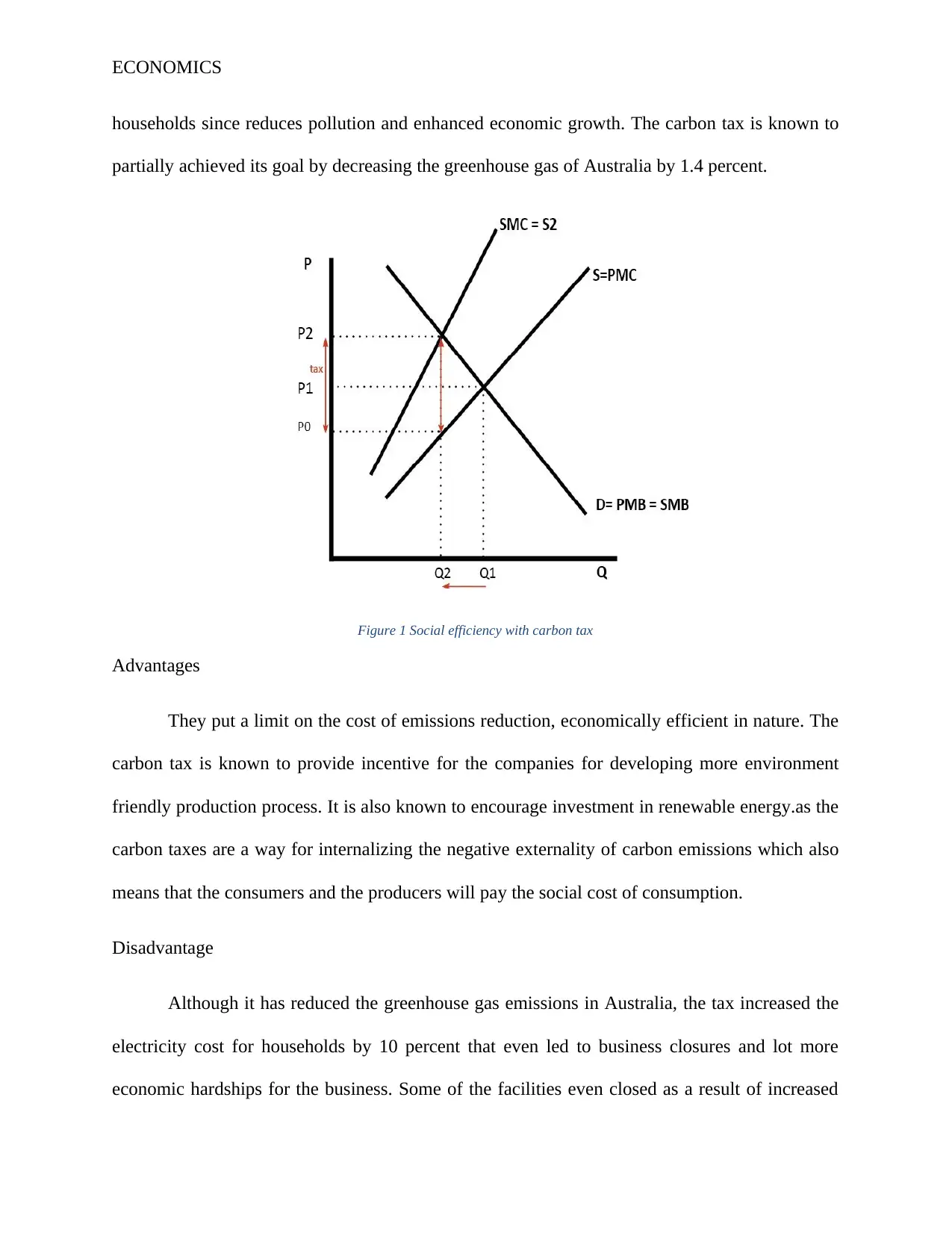
ECONOMICS
households since reduces pollution and enhanced economic growth. The carbon tax is known to
partially achieved its goal by decreasing the greenhouse gas of Australia by 1.4 percent.
Figure 1 Social efficiency with carbon tax
Advantages
They put a limit on the cost of emissions reduction, economically efficient in nature. The
carbon tax is known to provide incentive for the companies for developing more environment
friendly production process. It is also known to encourage investment in renewable energy.as the
carbon taxes are a way for internalizing the negative externality of carbon emissions which also
means that the consumers and the producers will pay the social cost of consumption.
Disadvantage
Although it has reduced the greenhouse gas emissions in Australia, the tax increased the
electricity cost for households by 10 percent that even led to business closures and lot more
economic hardships for the business. Some of the facilities even closed as a result of increased
households since reduces pollution and enhanced economic growth. The carbon tax is known to
partially achieved its goal by decreasing the greenhouse gas of Australia by 1.4 percent.
Figure 1 Social efficiency with carbon tax
Advantages
They put a limit on the cost of emissions reduction, economically efficient in nature. The
carbon tax is known to provide incentive for the companies for developing more environment
friendly production process. It is also known to encourage investment in renewable energy.as the
carbon taxes are a way for internalizing the negative externality of carbon emissions which also
means that the consumers and the producers will pay the social cost of consumption.
Disadvantage
Although it has reduced the greenhouse gas emissions in Australia, the tax increased the
electricity cost for households by 10 percent that even led to business closures and lot more
economic hardships for the business. Some of the facilities even closed as a result of increased
Paraphrase This Document
Need a fresh take? Get an instant paraphrase of this document with our AI Paraphraser
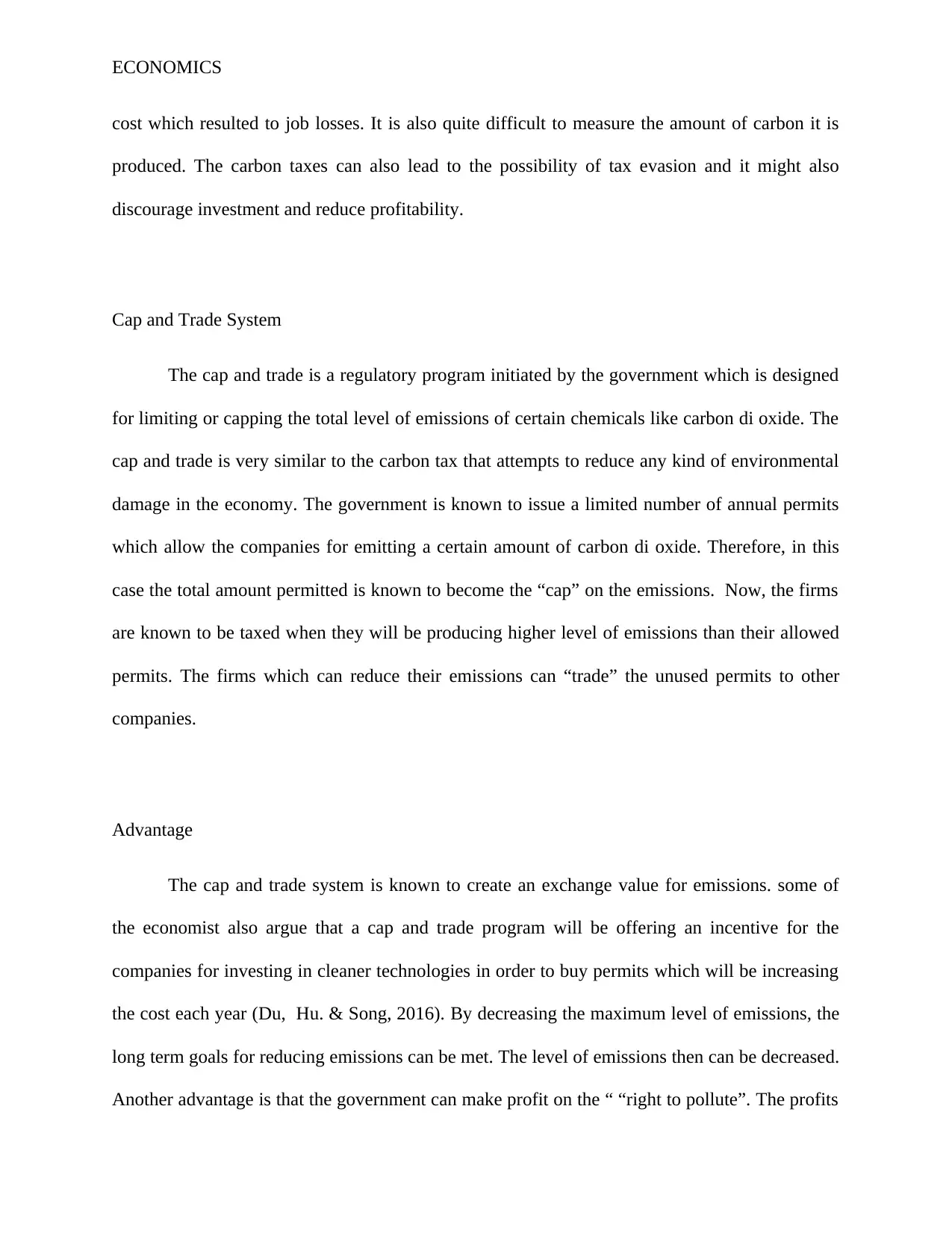
ECONOMICS
cost which resulted to job losses. It is also quite difficult to measure the amount of carbon it is
produced. The carbon taxes can also lead to the possibility of tax evasion and it might also
discourage investment and reduce profitability.
Cap and Trade System
The cap and trade is a regulatory program initiated by the government which is designed
for limiting or capping the total level of emissions of certain chemicals like carbon di oxide. The
cap and trade is very similar to the carbon tax that attempts to reduce any kind of environmental
damage in the economy. The government is known to issue a limited number of annual permits
which allow the companies for emitting a certain amount of carbon di oxide. Therefore, in this
case the total amount permitted is known to become the “cap” on the emissions. Now, the firms
are known to be taxed when they will be producing higher level of emissions than their allowed
permits. The firms which can reduce their emissions can “trade” the unused permits to other
companies.
Advantage
The cap and trade system is known to create an exchange value for emissions. some of
the economist also argue that a cap and trade program will be offering an incentive for the
companies for investing in cleaner technologies in order to buy permits which will be increasing
the cost each year (Du, Hu. & Song, 2016). By decreasing the maximum level of emissions, the
long term goals for reducing emissions can be met. The level of emissions then can be decreased.
Another advantage is that the government can make profit on the “ “right to pollute”. The profits
cost which resulted to job losses. It is also quite difficult to measure the amount of carbon it is
produced. The carbon taxes can also lead to the possibility of tax evasion and it might also
discourage investment and reduce profitability.
Cap and Trade System
The cap and trade is a regulatory program initiated by the government which is designed
for limiting or capping the total level of emissions of certain chemicals like carbon di oxide. The
cap and trade is very similar to the carbon tax that attempts to reduce any kind of environmental
damage in the economy. The government is known to issue a limited number of annual permits
which allow the companies for emitting a certain amount of carbon di oxide. Therefore, in this
case the total amount permitted is known to become the “cap” on the emissions. Now, the firms
are known to be taxed when they will be producing higher level of emissions than their allowed
permits. The firms which can reduce their emissions can “trade” the unused permits to other
companies.
Advantage
The cap and trade system is known to create an exchange value for emissions. some of
the economist also argue that a cap and trade program will be offering an incentive for the
companies for investing in cleaner technologies in order to buy permits which will be increasing
the cost each year (Du, Hu. & Song, 2016). By decreasing the maximum level of emissions, the
long term goals for reducing emissions can be met. The level of emissions then can be decreased.
Another advantage is that the government can make profit on the “ “right to pollute”. The profits
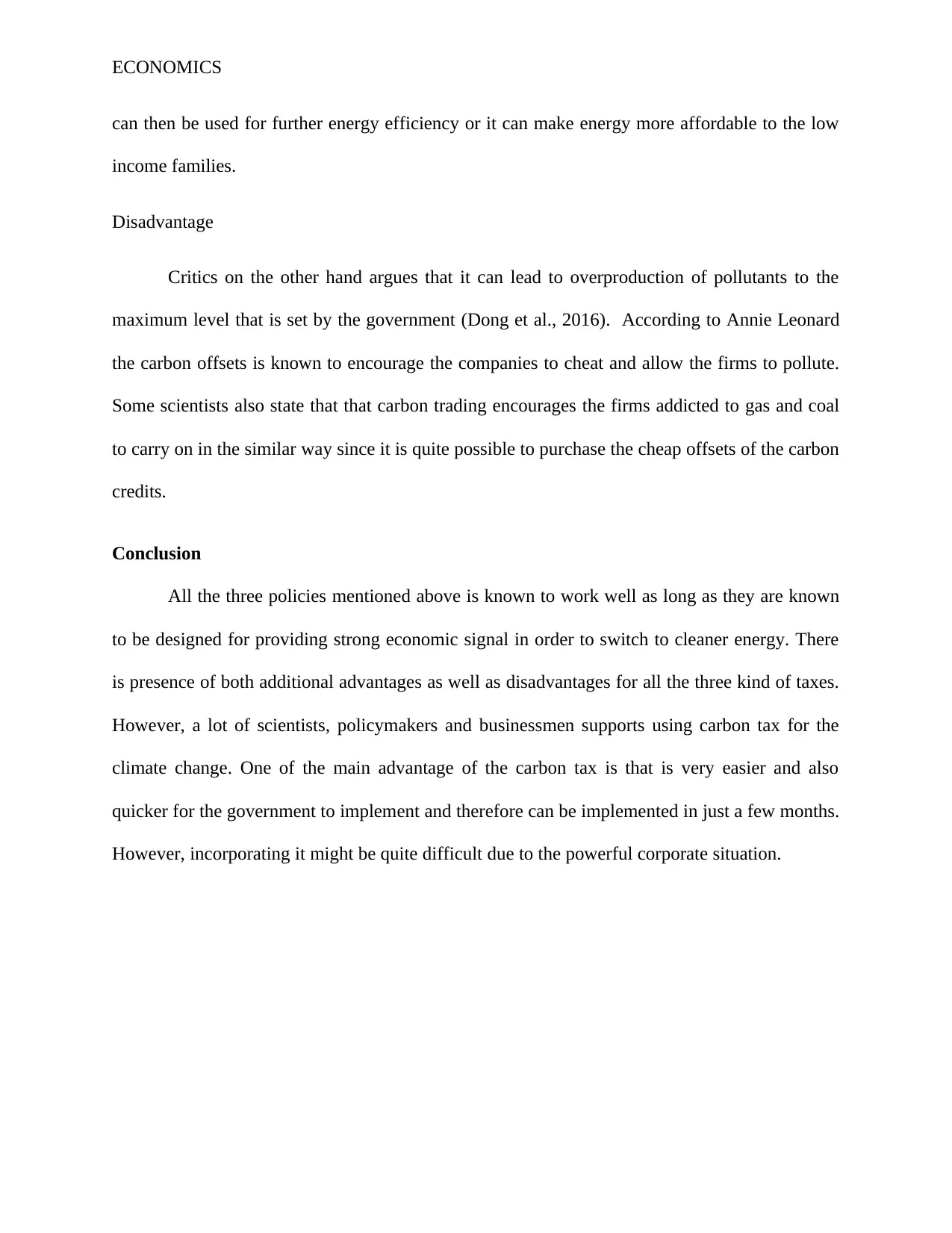
ECONOMICS
can then be used for further energy efficiency or it can make energy more affordable to the low
income families.
Disadvantage
Critics on the other hand argues that it can lead to overproduction of pollutants to the
maximum level that is set by the government (Dong et al., 2016). According to Annie Leonard
the carbon offsets is known to encourage the companies to cheat and allow the firms to pollute.
Some scientists also state that that carbon trading encourages the firms addicted to gas and coal
to carry on in the similar way since it is quite possible to purchase the cheap offsets of the carbon
credits.
Conclusion
All the three policies mentioned above is known to work well as long as they are known
to be designed for providing strong economic signal in order to switch to cleaner energy. There
is presence of both additional advantages as well as disadvantages for all the three kind of taxes.
However, a lot of scientists, policymakers and businessmen supports using carbon tax for the
climate change. One of the main advantage of the carbon tax is that is very easier and also
quicker for the government to implement and therefore can be implemented in just a few months.
However, incorporating it might be quite difficult due to the powerful corporate situation.
can then be used for further energy efficiency or it can make energy more affordable to the low
income families.
Disadvantage
Critics on the other hand argues that it can lead to overproduction of pollutants to the
maximum level that is set by the government (Dong et al., 2016). According to Annie Leonard
the carbon offsets is known to encourage the companies to cheat and allow the firms to pollute.
Some scientists also state that that carbon trading encourages the firms addicted to gas and coal
to carry on in the similar way since it is quite possible to purchase the cheap offsets of the carbon
credits.
Conclusion
All the three policies mentioned above is known to work well as long as they are known
to be designed for providing strong economic signal in order to switch to cleaner energy. There
is presence of both additional advantages as well as disadvantages for all the three kind of taxes.
However, a lot of scientists, policymakers and businessmen supports using carbon tax for the
climate change. One of the main advantage of the carbon tax is that is very easier and also
quicker for the government to implement and therefore can be implemented in just a few months.
However, incorporating it might be quite difficult due to the powerful corporate situation.
⊘ This is a preview!⊘
Do you want full access?
Subscribe today to unlock all pages.

Trusted by 1+ million students worldwide
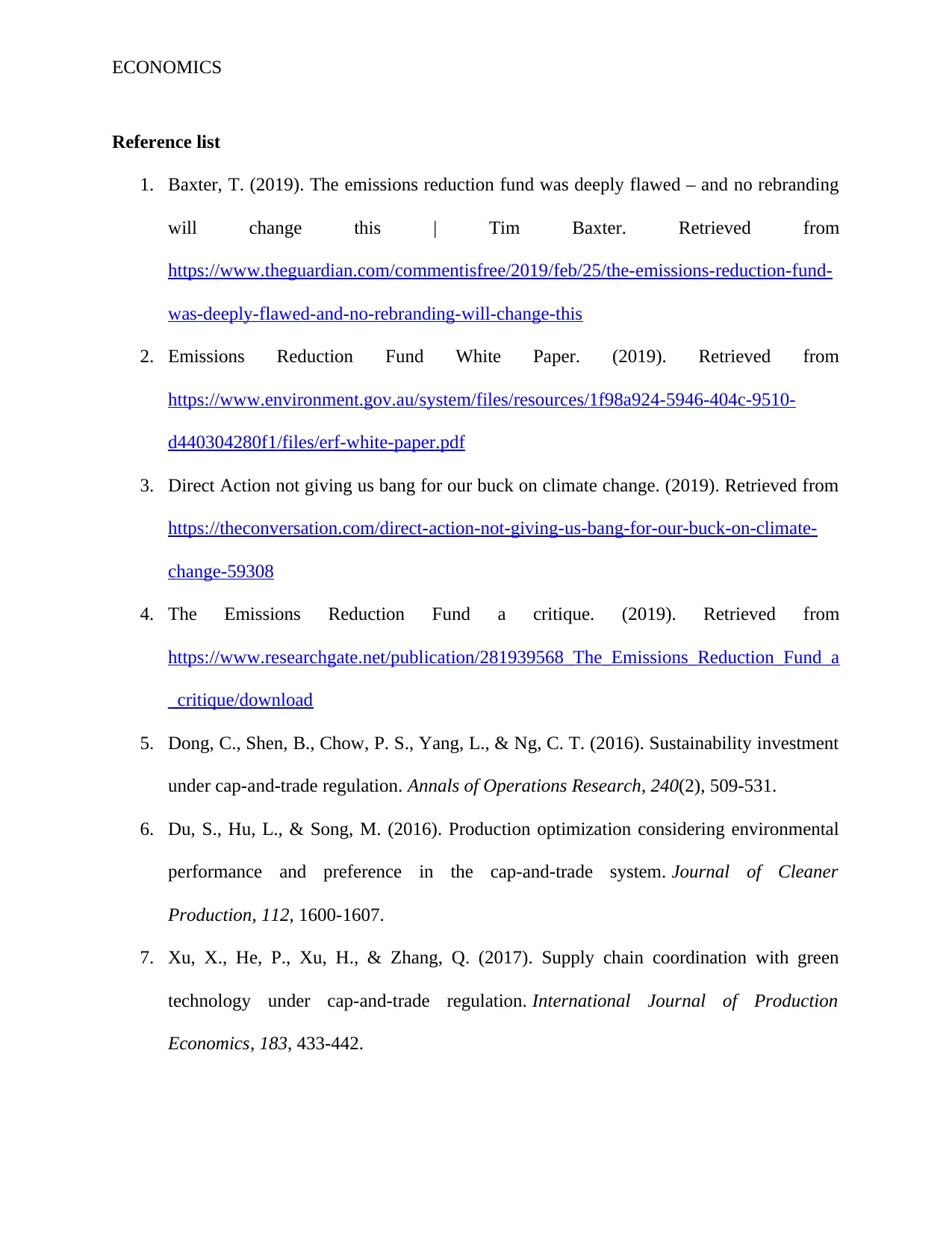
ECONOMICS
Reference list
1. Baxter, T. (2019). The emissions reduction fund was deeply flawed – and no rebranding
will change this | Tim Baxter. Retrieved from
https://www.theguardian.com/commentisfree/2019/feb/25/the-emissions-reduction-fund-
was-deeply-flawed-and-no-rebranding-will-change-this
2. Emissions Reduction Fund White Paper. (2019). Retrieved from
https://www.environment.gov.au/system/files/resources/1f98a924-5946-404c-9510-
d440304280f1/files/erf-white-paper.pdf
3. Direct Action not giving us bang for our buck on climate change. (2019). Retrieved from
https://theconversation.com/direct-action-not-giving-us-bang-for-our-buck-on-climate-
change-59308
4. The Emissions Reduction Fund a critique. (2019). Retrieved from
https://www.researchgate.net/publication/281939568_The_Emissions_Reduction_Fund_a
_critique/download
5. Dong, C., Shen, B., Chow, P. S., Yang, L., & Ng, C. T. (2016). Sustainability investment
under cap-and-trade regulation. Annals of Operations Research, 240(2), 509-531.
6. Du, S., Hu, L., & Song, M. (2016). Production optimization considering environmental
performance and preference in the cap-and-trade system. Journal of Cleaner
Production, 112, 1600-1607.
7. Xu, X., He, P., Xu, H., & Zhang, Q. (2017). Supply chain coordination with green
technology under cap-and-trade regulation. International Journal of Production
Economics, 183, 433-442.
Reference list
1. Baxter, T. (2019). The emissions reduction fund was deeply flawed – and no rebranding
will change this | Tim Baxter. Retrieved from
https://www.theguardian.com/commentisfree/2019/feb/25/the-emissions-reduction-fund-
was-deeply-flawed-and-no-rebranding-will-change-this
2. Emissions Reduction Fund White Paper. (2019). Retrieved from
https://www.environment.gov.au/system/files/resources/1f98a924-5946-404c-9510-
d440304280f1/files/erf-white-paper.pdf
3. Direct Action not giving us bang for our buck on climate change. (2019). Retrieved from
https://theconversation.com/direct-action-not-giving-us-bang-for-our-buck-on-climate-
change-59308
4. The Emissions Reduction Fund a critique. (2019). Retrieved from
https://www.researchgate.net/publication/281939568_The_Emissions_Reduction_Fund_a
_critique/download
5. Dong, C., Shen, B., Chow, P. S., Yang, L., & Ng, C. T. (2016). Sustainability investment
under cap-and-trade regulation. Annals of Operations Research, 240(2), 509-531.
6. Du, S., Hu, L., & Song, M. (2016). Production optimization considering environmental
performance and preference in the cap-and-trade system. Journal of Cleaner
Production, 112, 1600-1607.
7. Xu, X., He, P., Xu, H., & Zhang, Q. (2017). Supply chain coordination with green
technology under cap-and-trade regulation. International Journal of Production
Economics, 183, 433-442.
Paraphrase This Document
Need a fresh take? Get an instant paraphrase of this document with our AI Paraphraser
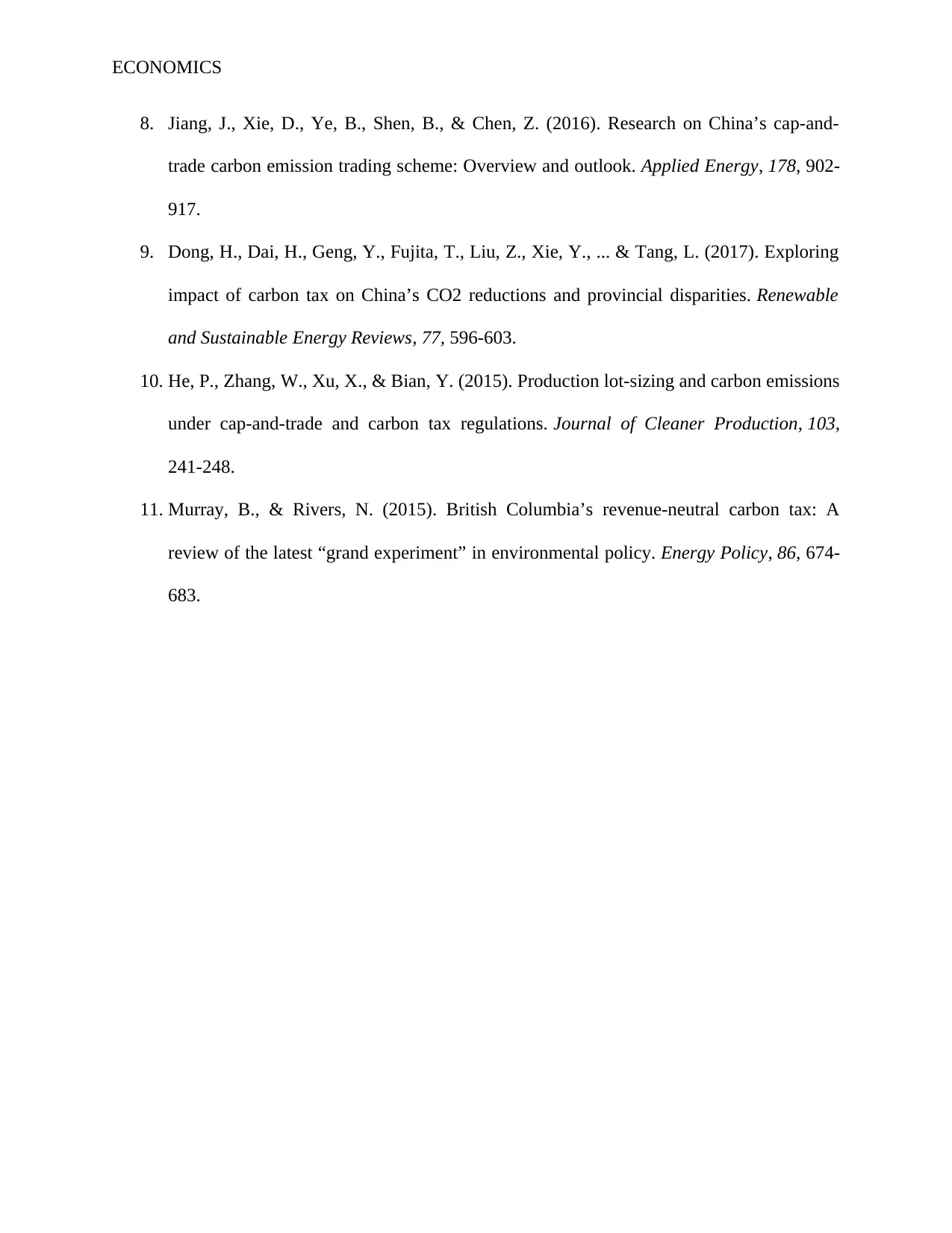
ECONOMICS
8. Jiang, J., Xie, D., Ye, B., Shen, B., & Chen, Z. (2016). Research on China’s cap-and-
trade carbon emission trading scheme: Overview and outlook. Applied Energy, 178, 902-
917.
9. Dong, H., Dai, H., Geng, Y., Fujita, T., Liu, Z., Xie, Y., ... & Tang, L. (2017). Exploring
impact of carbon tax on China’s CO2 reductions and provincial disparities. Renewable
and Sustainable Energy Reviews, 77, 596-603.
10. He, P., Zhang, W., Xu, X., & Bian, Y. (2015). Production lot-sizing and carbon emissions
under cap-and-trade and carbon tax regulations. Journal of Cleaner Production, 103,
241-248.
11. Murray, B., & Rivers, N. (2015). British Columbia’s revenue-neutral carbon tax: A
review of the latest “grand experiment” in environmental policy. Energy Policy, 86, 674-
683.
8. Jiang, J., Xie, D., Ye, B., Shen, B., & Chen, Z. (2016). Research on China’s cap-and-
trade carbon emission trading scheme: Overview and outlook. Applied Energy, 178, 902-
917.
9. Dong, H., Dai, H., Geng, Y., Fujita, T., Liu, Z., Xie, Y., ... & Tang, L. (2017). Exploring
impact of carbon tax on China’s CO2 reductions and provincial disparities. Renewable
and Sustainable Energy Reviews, 77, 596-603.
10. He, P., Zhang, W., Xu, X., & Bian, Y. (2015). Production lot-sizing and carbon emissions
under cap-and-trade and carbon tax regulations. Journal of Cleaner Production, 103,
241-248.
11. Murray, B., & Rivers, N. (2015). British Columbia’s revenue-neutral carbon tax: A
review of the latest “grand experiment” in environmental policy. Energy Policy, 86, 674-
683.
1 out of 8
Related Documents
Your All-in-One AI-Powered Toolkit for Academic Success.
+13062052269
info@desklib.com
Available 24*7 on WhatsApp / Email
![[object Object]](/_next/static/media/star-bottom.7253800d.svg)
Unlock your academic potential
Copyright © 2020–2025 A2Z Services. All Rights Reserved. Developed and managed by ZUCOL.





